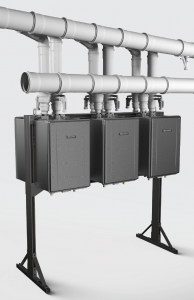Common-Venting Tankless Water Heaters
As a contractor, your number one question when installing a water heating product likely is: “How simple or complex is the job?” When you hear about a new product, you probably evaluate its worth based on what labor and time savings it can offer you and your crew.
you probably evaluate its worth based on what labor and time savings it can offer you and your crew.
If you’ve seen the new NCC199CDV condensing tankless water heater from Noritz, designed for commercial applications, you may have noticed that is has been approved for common-venting up to six units by the CSA Group (formerly the Canadian Standards Association). This labor-saving feature may be enough to justify the product in your eyes. If not, let’s walk through exactly what this common-venting capability means for your installers.
As you may know, common venting differs from individual venting in that it allows multiple tankless water heating units to share a single vent in an application. This brings with it a number of installation benefits.
Reduced vent terminations
Since you are running multiple water heating units through one vent in a common-vented application, you save the time it could have taken to make all those additional wall or roof penetrations. Consider the use of 24 NCC199CDV heaters in a large commercial application. Since up to six can be common-vented together, it means you would need only four penetrations. Venting the 24 units individually would involve six times the penetrations and six times the work.
Fewer necessary supports
Fewer vent pipes also means less labor and lower material costs when it comes to adding necessary support hangers for each of your runs. Installing support hangers can become extremely labor-intensive on larger commercial projects when the vent runs climb into the double digits. A unit like the NCC199CDV needs only one set of hanger supports per six water heaters.
Longer vent runs
In general, a common-vented configuration will allow you to run venting for longer distances and broaden your installation flexibility. According to Randy Oshiro, Lead Engineer at Noritz, the maximum run for common venting up to four units with 8-inch diameter pipe is 200 feet. The maximum run for individual venting with 3-inch diameter pipe is only half that distance.
Cleaner aesthetic
Finally, a common-vented system offers a much cleaner look. The potentially large number of vents and terminations required for an individually vented, commercial configuration could make the site look messy and cramped when compared with a common vent.
Common venting clearly has its benefits for commercial applications, which is why the NCC199CDV can be a game-changing product for many installers. To learn more, please visit https://www.noritz.com/products/ncc199cdv/
